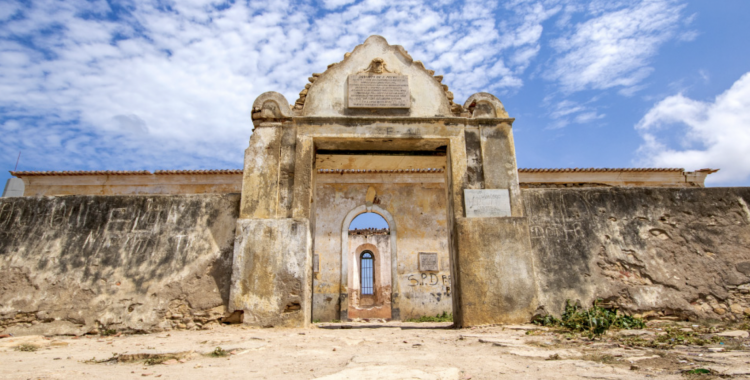Built on a hill on the banks of the Catumbela River by Portuguese forces, the entrance features the following description: "It was built at the expense of the inhabitants of Benguela, in honour of the worthy Municipal Council. The continuous insults made to the whites by the indigenous people of this district led to the construction of this stronghold. The garrisons of the brigs Mondego, Tâmega and the corvette Relâmpago, commanded by Chief F. A. Glz Cardodo, will subdue them by order of the Governor General, the Hon. Pedro Alexandrino da Cunha, F. X. Lopes Major of the Exto., drew and built the first stone on 5 October 1846".
The origin of this structure is reported by historian and tourist guide Jorge Augusto, 62 years old, retired and the first person responsible for Culture in Catumbela, according to whom the Fort of S. Pedro was built to suppress the Catumbela revolts.
"In the past, the Portuguese who settled in Benguela, faced with the unhealthiness of the place where the town of Benguela was located, became concerned and demanded that its leaders find a better place, one that offered better sanitary conditions. Among several places, this was the most ideal", he said.
This was how, around 1618, the historian continued, the Portuguese, led by Cerveira Pereira, expelled the local traditional authorities, who lived on both banks of the Catumbela River, which led to many clashes, which lasted from 1618 until 1647.
Another inscription with an epigraph reads: "This stronghold was classified as a monument of public interest by order no. 8579 of 17 June 1954, and restored from April to June of the same year, with Captain José Agapito da Silva Carvalho as governor general".
Today, that structure – which, according to another epigraph, received "A visit from the President of the Portuguese Republic, General Francisco Higino Craveiro Lopes, to the Fort of S. Pedro da Catumbela, built in 1846-1847, by his great-grandfather, then Major Francisco Xavier Lopes, on 17 June 1954" – requires a new restoration.
Totally uncovered, Jorge Augusto said that it was left that way when the 4 de Abril Bridge was built, the newest of the four over the Catumbela River, inaugurated in 2009.
Jorge Augusto explained that, at the time of the bridge's construction, there was also a project to transform the fort into something he could not explain, but the idea did not go ahead.
"That's why the roof was removed. There was a plan to make something out of it, but the Ministry of Culture rejected it, which is why it was left without a roof. (...) It was still in good condition, it had tiles and beams, they removed them and piled them up inside the space, but the cronies took everything and it was left like this", he lamented.
Despite its state of degradation, the fort is visited mainly by national students and academics, but also by foreign tourists who travel to Benguela, said the historian, rejoicing that the history of that place "has had an impact abroad", referring to American visitors who arrive on cruise ships.
If it continues like this, without any garrison, in a state of abandonment, there is a risk of its history being erased, said Jorge Augusto.
"We are on the verge of having it disappear (...). If it were rehabilitated we would have that security, but since it is in ruins, no one has yet thought about its security", he added.
With attention now focused on the Lobito Corridor, a railway infrastructure that connects Angola to the mining areas of the Democratic Republic of Congo and Zambia, it is urgent to restore places like this, tourist attractions, and "pay taxes to the State's coffers", the tour guide argued.
And as history repeats itself, the site once again served as a military garrison. A plaque inside the military structure, in one of its compartments, that says "Command of the 3rd CIA" is striking.
When asked what this meant, Jorge Augusto explained that in 1992, during the post-electoral conflict, an artillery command was placed there to guard the bridge, so that it would not be destroyed.
From that location, the view also reaches the first residence of the first colonial administrator, built in 1770 and inaugurated in 1836, by Decree of D. Maria II, Queen of Portugal, also in an advanced state of degradation.
"[It was] the chief's house, there was a village here. The Portuguese had the idea of moving the village of Benguela to this place. Before, Catumbela was called Asseiceira and they wanted to have cohabitation with the Europeans, but the natives did not accept it and continued to attack this village, so the Portuguese had to send for reinforcements in the form of three ships that managed to defeat the resistance of the elders", he said.







